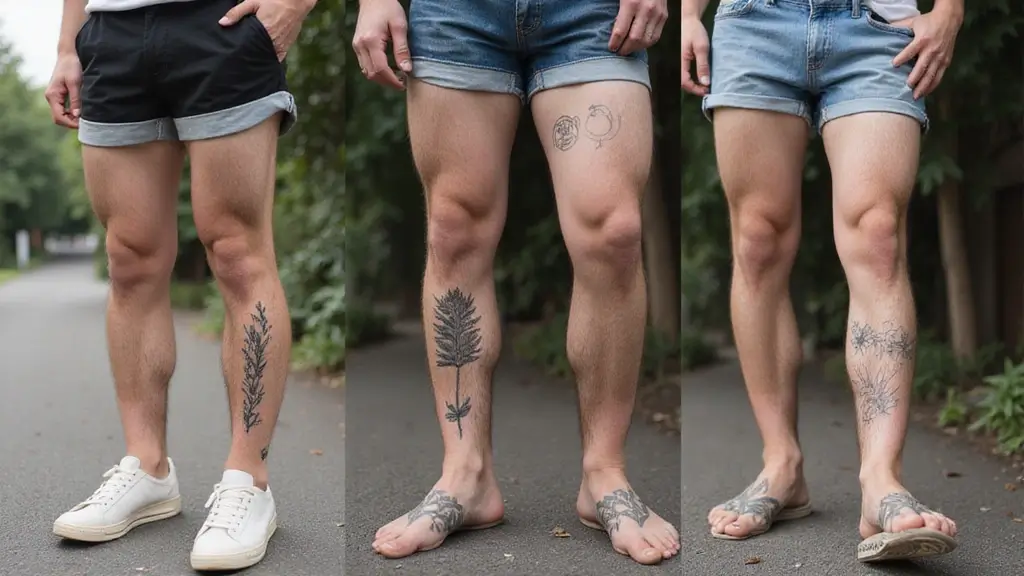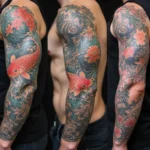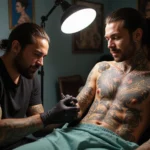Leg tattoos are becoming a popular canvas for men’s body art, and it’s easy to see why. They’re versatile, easily coverable yet accessible for those who want to showcase their unique style.
Whether you’re looking for something minimalistic or a bold statement piece, leg tattoos can embody your personal journey, beliefs, or simply reflect your aesthetic preferences.
In this collection, we dive into 30 exceptional leg tattoo ideas specifically designed for men, focusing on minimalistic styles that maintain a masculine edge. Get ready to be inspired and find the perfect design that resonates with your individuality.
1. Geometric Patterns

Geometric tattoos are all the rage right now, and for good reason!
These designs are not just aesthetically pleasing but also pack a punch in terms of symbolism. Clean lines and sharp angles create impressive visuals that can highlight the natural contours of your leg.
Consider a design that wraps around your calf or thigh, creating a mesmerizing illusion.
– Geometric designs can easily blend into other styles, making them versatile.
– Opt for black ink for a striking effect or incorporate subtle colors for a softer look.
– These tattoos often represent balance and harmony, making them a meaningful choice.
– Discuss your design with a trusted tattoo artist to ensure it fits your leg shape well.
– Consider how the design can evolve if you want to add more tattoos later.
2. Nature-Inspired Tattoos

If you’re an outdoor enthusiast, nature-inspired leg tattoos can connect you to your passions.
From delicate floral designs to majestic mountains, these tattoos can be as detailed or as simplistic as you like.
Imagining a tall pine tree or a cluster of wildflowers blooming on your calf not only showcases your love for nature but also can serve as a reminder of tranquility.
– Nature tattoos can symbolize growth, resilience, and freedom.
– They can be adapted into minimalist styles to suit your taste while still making a bold statement.
– Choose colors that resonate with nature, like earthy greens and browns, or stick to monochrome for a minimalist vibe.
– Research local flora and fauna for unique designs that pay homage to your surroundings.
3. Abstract Lines

Abstract tattoos are perfect for those who want something unique yet classy.
These tattoos often feature flowing lines and shapes that can represent abstract concepts or personal meanings. A design wrapping around your thigh or calf can flow with the movement of your leg, creating an eye-catching piece that attracts attention without being overly complicated.
– They can be interpreted differently by each viewer, adding an element of mystery.
– Abstract tattoos can be customized to reflect personal experiences or feelings, making them deeply meaningful.
– Work closely with your tattoo artist to ensure the design truly reflects your vision.
– Consider how the tattoo can complement or contrast with other tattoos you might have.
4. Minimalist Animals

Animal tattoos can carry strong symbolism and reflect traits you admire or identify with.
Minimalist animal designs, like a sleek wolf or a simple eagle outline, can be visually striking while maintaining a sense of elegance. These tattoos often embody qualities such as strength, freedom, and loyalty.
– Minimalist animal tattoos allow for personal interpretation, making them more relatable.
– You can place them strategically for better visibility or cover them up when needed.
– Choose an animal that resonates with your personality or conveys a significant meaning to you.
– Discuss the size and placement with your artist to ensure it looks proportionate on your leg.
Minimalist animal tattoos are more than just ink; they symbolize the traits you admire. Show your strength and freedom with a design that’s both elegant and personal!
5. Symbolic Shapes

Simple shapes can hold profound meanings in tattoo art.
Whether it’s a circle symbolizing wholeness or triangles representing change, these minimalist symbols can create a bold impact on your leg. A pattern of interconnected shapes can provide a unique twist to a simple idea.
– Abstract shapes are timeless and can be easily adapted over time.
– They allow for personalization; each person may interpret the shape in their way.
– Think about the message you want to convey with each shape.
– Discuss color options and placement with your tattoo artist for maximum effect.
6. Coordinates Tattoo

For those with a place close to their heart, coordinates tattoos can offer a personal touch.
These minimalist designs typically showcase latitude and longitude numbers that mark a significant location, whether it’s where you were born or a memorable travel experience. A simple numerical tattoo on your leg can evoke powerful memories while remaining understated.
– Coordinates can serve as a conversation starter, allowing you to share your story.
– They can be easily integrated with other elements like symbols or dates.
– Double-check the accuracy of the coordinates before getting inked.
– Consider pairing it with a minimalist map design for added effect.
7. Simple Quotes

While minimalist tattoos are often devoid of words, a carefully selected quote can add depth to your leg tattoo.
Choose a short phrase or word that resonates with you, encapsulating your beliefs or aspirations. Clean lines and simple fonts enhance the elegance of the tattoo, making it a powerful statement piece on your leg.
– Quotes can serve as daily reminders of motivation and inspiration.
– They offer unlimited personalization based on your individual journey.
– Keep the quote short to ensure clarity and visual appeal.
– Select a location that allows for easy visibility of your quote.
8. Tribal Designs

Tribal tattoos have a rich history, and minimalist versions can be just as striking.
These designs typically feature bold lines and patterns that connect to cultural heritage or personal story. A simple tribal motif can wrap around the leg, adding a sense of strength and identity.
– Tribal tattoos can represent community, strength, and a deep connection to one’s roots.
– They allow for a unique story tied to personal or cultural significance.
– Research the meanings behind different tribal designs to ensure you find one that resonates with you.
– Consider the flow of the design in relation to your body shape for the perfect placement.
9. Minimalist Portraits

Portrait tattoos don’t always have to be intricate and detailed.
A minimalist portrait can capture the essence of a person or a beloved pet through simple lines and outlines. A face or silhouette inked on your leg can carry a lot of emotional weight while keeping the overall design light and straightforward.
– These tattoos can tell a personal story, representing a significant person in your life.
– They offer a unique balance of simplicity and sentimentality.
– Find a tattoo artist skilled in minimalist designs to ensure a high-quality result.
– Discuss the size and placement for maximum visual impact.
10. Celestial Tattoos

Celestial tattoos embrace elements such as stars, moons, and suns, often symbolizing guidance and dreams.
These designs can be minimalist in style, making them perfect for the leg area. A few delicate stars or a crescent moon can create an enchanting effect, making your leg a beautiful canvas for your cosmic love.
– Celestial tattoos can represent hope, ambition, and the infinite nature of the universe.
– They provide a whimsical touch to your body art without overwhelming the visual space.
– Consider a night sky theme with simple stars and moons for a cohesive look.
– Discuss color options that resonate with your personal style.
11. Arrow Tattoos

Arrow tattoos signify direction, movement, and ambition.
A minimalist arrow inked on your leg can symbolize your journey and the goals you aim to achieve. Simple, clean lines can make this tattoo both masculine and elegant, fitting perfectly on your calf or thigh.
– Arrows can represent resilience; they can only go forward, never backward.
– This tattoo can be expanded with additional elements like feathers or quotes for a more personal touch.
– Choose a design that reflects your personal journey or aspirations.
– Discuss with your artist how to position the arrow for the best visual flow.
An arrow tattoo is more than just ink; it’s a powerful symbol of resilience. Just like an arrow, your journey only moves forward—aim high, and let your ambitions lead the way!
12. Waves and Water Designs

For those who feel connected to the ocean, minimalist wave tattoos can be a breathtaking choice.
A simple line of waves on your leg can evoke a sense of tranquility while reflecting your love for water. These designs mirror life’s ebb and flow, making them a profound representation of life’s journey.
– Water tattoos can symbolize change, adaptability, and freedom.
– They can be designed to fit the shape of your leg, creating a personalized piece.
– Choose a design style that resonates with your personal connection to water.
– Consider how the tattoo will look with your movement for maximum effect.
13. Compass Tattoos

Compass tattoos symbolize navigation and the journey of life.
A minimalist compass inked on your leg can reflect your adventurous spirit and desire to explore the unknown. The clean lines and simple design allow the tattoo to seamlessly fit into various styles without being overpowering.
– They can represent finding your direction in life, making them a meaningful choice.
– Consider adding elements like mountains or a map to enhance the design.
– Discuss the placement to ensure it flows with your leg’s natural shape.
– Opt for subtle details to keep the minimalist aesthetic intact.
14. Musical Notes

For music lovers, minimalist musical notes can capture your passion in a unique way.
A small treble or bass clef can adorn your leg, representing the music that moves you. Minimalist designs allow for elegance and personality, creating a harmonious blend of art and identity.
– These tattoos can symbolize your love for music or a specific moment linked to a song.
– You can incorporate other elements like instruments or lyrics for added meaning.
– Choose a note that resonates with your musical journey for a more personal touch.
– Discuss the size for optimal visibility and impact.
15. Boxed Designs

Boxed tattoos create structure and definition, making them a unique choice for leg tattoos.
These designs can range from geometric shapes encased in a box to more complex images within a bordered area. The contrast of the boxed elements against the skin can create a visually striking effect.
– They can symbolize boundaries or a personal space, adding an interesting angle to your tattoo.
– Boxed tattoos can be customized with different patterns or images within them.
– Discuss the content you want inside the box for a truly unique design.
– Consider placement based on what you want the tattoo to communicate.
16. Labyrinth Tattoos

Labyrinth tattoos can symbolize the complex journey of life, representing the challenges and paths we navigate.
A minimalist labyrinth design on your leg can evoke a sense of contemplation and introspection. The simple lines create a captivating visual, allowing you to reflect on your adventures.
– These designs can represent personal growth and finding one’s way.
– They allow for customization, with various paths representing different experiences.
– Choose a design that resonates with your journey for deeper personal significance.
– Discuss with your artist how intricate you want the labyrinth to be.
17. Feather Tattoos

Feather tattoos are often associated with freedom, transcendence, and spirituality.
A minimalist feather design inked on your leg can symbolize personal growth and the journey towards your dreams. The delicate lines can flow beautifully along the shape of your leg, creating an elegant statement.
– Feathers can be designed in various styles, from realistic to abstract, allowing for personal expression.
– They can also be paired with other elements like birds or arrows for added meaning.
– Discuss size and placement that best highlight the feather’s elegance and flow.
– Consider color options that resonate with your personal style.
18. Lightning Bolt Tattoos

Lightning bolt tattoos represent power, strength, and sudden change.
A minimalist lightning bolt inked on your leg can capture that raw energy while making a bold statement. The sharp lines and angles create an eye-catching effect that resonates with personal empowerment and determination.
– This design can symbolize overcoming obstacles, making it a motivational piece.
– Lightning bolts can be easily combined with other elements for a more complex design.
– Choose a position that emphasizes the bolt’s movement and energy.
– Discuss color options for a more dynamic look or stick to monochrome for a classic style.
19. Sun and Moon Tattoos

Sun and moon tattoos represent duality and balance, making them perfect for leg art.
A minimalist design featuring both elements can symbolize harmony between opposites, showcasing their beauty through clean lines. A delicate sun or crescent moon can create a captivating focal point on your leg.
– These tattoos can remind you of the balance you seek in life.
– They allow for creative combinations, like adding stars for a night sky theme.
– Discuss with your artist how to position the sun and moon to create a cohesive look.
– Consider color palettes that reflect your personality and style.
20. Handwritten Scripts

Handwritten script tattoos can offer a personal touch to your leg art.
A single word or phrase that holds meaning to you, tattooed in an elegant handwritten font, can make a lovely statement. This minimalist style allows for a deeper connection with the tattoo’s message without overwhelming visuals.
– Handwritten scripts can represent quotes, names, or even short messages that inspire you.
– The fluidity of the script can flow with the shape of your leg for added elegance.
– Choose a script that is legible and resonates with your style.
– Discuss the placement to maximize visibility and emotional impact.
21. Minimalist Squares

Square tattoos symbolize stability, balance, and structure.
A minimalist square inked on your leg can resonate with those who appreciate simplicity and symmetry. This design can serve as a reminder of personal grounding and the importance of maintaining balance in life.
– Squares can be combined with other shapes or elements for a more complex design.
– They represent strength and resilience, making them a powerful choice.
– Position the square thoughtfully to create a natural flow on your leg.
– Consider color options that reflect your personality, whether monochrome or bold hues.
22. Minimalist Cross Tattoos

Cross tattoos can hold deep personal significance, representing faith, belief, and sacrifice.
A minimalist cross design on your leg can blend spirituality with a modern aesthetic. This style allows for elegant simplicity that makes a bold statement without being overly complex.
– Minimalist crosses can be easily adapted to fit your personal faith or beliefs.
– They can also represent a loved one or a significant moment in your life.
– Choose a design that resonates with your spiritual journey.
– Discuss size and placement to maximize the tattoo’s visibility and meaning.
23. Simple Circles

Circle tattoos are timeless and can represent eternity, wholeness, or cycles.
A minimalist circle design on your leg can symbolize completeness and the journey of life. These clean and simple designs can enhance your leg tattoo collection, providing a sense of balance.
– Circles can signify the completeness of life or reflect on personal experiences.
– They can be combined with other elements like lines or dots for added depth.
– Position the circle thoughtfully for maximum impact and visual flow.
– Consider color options, as this can change the meaning and vibe of the tattoo.
24. Dots and Lines

Dots and lines tattoos are a modern take on minimalism and can create unique visual effects.
Inked on your leg, these designs can create patterns that flow beautifully, representing connections and continuity. This minimalist approach allows for artistic expression without overwhelming your skin.
– It can symbolize your connection to the universe, creating a unique story.
– These tattoos are often open to interpretation, which adds to their charm.
– Discuss your vision with your artist to ensure the lines and dots flow with your leg’s natural curves.
– Consider how the design may evolve over time with additional elements.
Embrace the beauty of simplicity: Dots and lines tattoos tell a unique story while connecting you to the universe. Let your leg tattoo for men be a canvas for your artistic expression!
25. Minimalist Skeleton Keys

Skeleton key tattoos are steeped in symbolism, representing access, knowledge, and unlocking your potential.
A minimalist key design on your leg can convey the idea of new beginnings and opportunities. The clean lines and simple shapes are perfect for a striking yet subtle statement piece.
– A skeleton key design can reflect personal growth and unlocking new chapters in life.
– These tattoos can be personalized with different elements like hearts or flowers.
– Consider where the key should point for added symbolism.
– Discuss size and placement with your artist to ensure it suits your leg’s proportions.
26. Minimalist Planet Tattoos

Planet tattoos can symbolize your connection to the universe and your place within it.
A minimalist planet design on your leg can evoke a sense of wonder and curiosity about the cosmos. These clean and simple tattoos can create a bold statement about your love for exploration.
– Planet tattoos can reflect personal significance, such as noteworthy experiences tied to specific locations.
– They allow for customization with additional elements, like stars or moons.
– Choose colors that resonate with the planets you want to represent.
– Discuss placement to create a celestial theme on your leg.
27. Minimalist Book Tattoos

Books symbolize knowledge, stories, and journeys through literature.
A minimalist book tattoo on your leg can highlight your love for reading or represent a significant story in your life. This design can be simple yet impactful, making it a personal statement without being overly complex.
– Book tattoos can signify a journey of self-discovery or a favorite literary adventure.
– They can be paired with other elements like quotes or imagery to enhance the design.
– Choose a design that resonates with your literary preferences for a more personal touch.
– Discuss size and placement to ensure it fits well on your leg.
28. Minimalist Oak Tree

Oak trees symbolize strength, endurance, and longevity.
A minimalist oak tree tattoo on your leg can represent resilience and a deep connection to nature. The clean lines can enhance the beauty of the design while making a profound statement.
– An oak tree tattoo can reflect personal growth and grounding in life.
– It can be beautifully paired with other elements like leaves to enrich the design.
– Discuss the size and placement to ensure it captures the essence of the oak tree.
– Consider color choices that resonate with your connection to nature.
29. Minimalist Rocket Ship

Rocket ship tattoos symbolize ambition, adventure, and the desire to explore.
A minimalist rocket ship design on your leg can capture your thirst for discovery and personal growth. The clean lines create a striking visual that embodies your adventurous side without overwhelming your style.
– These tattoos can represent aspirations and the journey to reach your goals.
– They can be creatively combined with stars or planets for a more cosmic appeal.
– Choose a design that reflects your personal journey and aspirations for added meaning.
– Discuss placement to maximize the visual impact.
30. Minimalist Hourglass

Hourglass tattoos symbolize the passage of time and the importance of living in the moment.
A minimalist hourglass design on your leg can serve as a powerful reminder to cherish every second. The clean lines of the hourglass create a profound visual statement that resonates with many.
– These tattoos can remind you of life’s fleeting nature, encouraging mindfulness.
– They can be personalized with additional elements like sand or stars to enhance your design.
– Discuss size and placement with your artist for the best visual flow.
– Consider color choices that highlight the symbolism of time.
Embrace the moment with a minimalist hourglass tattoo on your leg. It’s not just ink; it’s a daily reminder to live fully and cherish every second.
Conclusion

Choosing a leg tattoo is an exciting journey of self-expression and individuality.
With these 30 minimalist designs, you have plenty of inspiration to find the perfect tattoo that speaks to you. Whether it’s a subtle symbol or a bold statement, remember that each tattoo tells part of your story.
Consider what resonates most and consult with a talented tattoo artist to bring your vision to life.
Frequently Asked Questions
What are the most popular leg tattoo designs for men?
When it comes to leg tattoos for men, some of the most popular designs include geometric patterns, nature-inspired tattoos, and minimalist animals. These designs not only look striking but also often carry deep personal meanings. Whether you prefer bold leg tattoos or more subtle minimalist styles, there’s something for everyone!
How do I choose the right leg tattoo for me?
Choosing the right leg tattoo starts with reflecting on what resonates with you personally. Think about your interests, values, and any unique tattoo ideas that represent your personality. Browse through designs like abstract lines, symbolic shapes, or even coordinates tattoos that hold special significance. Don’t forget to consider the placement and size of the tattoo to ensure it aligns with your style.
Are minimalist tattoos more painful than traditional tattoos?
Pain levels can vary for each individual, but generally, the pain associated with tattoos, including minimalist designs, largely depends on the location on the body rather than the tattoo style itself. Since leg tattoos are often on muscle or fat, they might be less painful than tattoos on bony areas. However, everyone’s pain tolerance is different, so it’s essential to prepare and discuss concerns with your tattoo artist.
How can I care for my leg tattoo after getting it done?
Proper care for your new leg tattoo is crucial for ensuring it heals well. Start by keeping the tattoo clean and moisturized. Use a gentle, fragrance-free soap and apply a thin layer of a recommended tattoo aftercare ointment to prevent infection. Avoid exposing it to direct sunlight or soaking it in water for at least two weeks. Following these steps will help your tattoo look vibrant and fresh for years to come!
What should I consider before getting a leg tattoo?
Before getting a leg tattoo, consider factors like design meaning, placement, and future job prospects. Some workplaces are more accepting of body art than others, so think about how visible you want your tattoo to be. Additionally, discuss your design ideas with a professional tattoo artist who can help refine your vision and ensure it translates well onto your skin!











